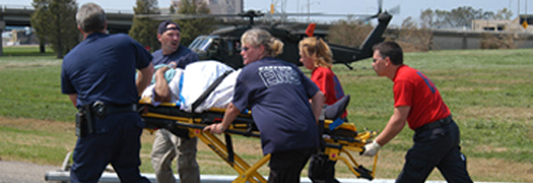
Preparing for a Mass Casualty Event: Information for Health Care Systems and Providers (see also Information for the Public)
Understanding Surge Capacity for Injuries
In the confusion that often follows a mass casualty event, such as a shooting, managing the rapid influx of large numbers of injured patients is challenging. Hospital administrators and health care providers can use this information to handle resource and staffing issues during a mass casualty event.
· Because many patients self-evacuate after a mass casualty event, and prehospital care may be difficult to coordinate, hospitals near the scene can expect to receive a large influx—or surge—of victims after the event.
· This rapid surge of victims typically occurs within minutes followed by injuries to workers involved in recovery procedures can lead to a secondary wave in surge.
· CDC in collaboration with experts in the areas of emergency medical services, emergency medicine, trauma surgery, burn surgery, pediatrics, otolaryngology, intensive care medicine, hospital medicine, radiology, pharmacology, nursing, hospital administration, laboratory medicine (blood bank), and public health identified creative strategies that could be adopted in a timely manner to address surge issues.
· Though developed in the context of a surge of injuries from a terrorist bombing, these recommendations may improve the response to and management of a surge of patients from any cause, including a shooting.
· The needs and resources of each community must be considered to effectively plan for a surge of patients into an already overburdened health care system.
· These proposed solutions for discipline-specific challenges have been incorporated into easy to use templates that can assist various disciplines in managing surge needs for injuries resulting from mass casualty events.
Revised Field Triage Decision Scheme
CDC in collaboration with the National Highway Traffic Safety Administration led a multidisciplinary effort to revise the previously nationally published field triage criteria published by the American College of Surgeons (ACS) in “Resources for Optimal Care of the Injured Patient,” 1999.
The 2006 field triage decision scheme is the set of criteria pertaining to the decision by pre-hospital personnel to transport trauma victims, to a specialized acute care facility (trauma center), versus an undesignated, non-specialized acute care facility.
· In 2006, CDC funded research confirmed the importance of rapid, efficient field triage. For the first time, we have evidence that care at a Level I trauma center lowers the risk of death by 25% for severely injured patients compared with treatment received at non-trauma centers.
· The goal of the decision scheme is to match the clinical needs of an injured patient to the resources and expertise of a given facility to care for them.
· These revised, evidence-based criteria provide the basis for field triage protocols for EMS and trauma systems and their injury care providers across the United States and are consistent with our changing dynamic healthcare and technological environment.
· This new decision scheme, anticipated for widespread use, provides a uniform, nationally consistent method of conducting field triage with the ultimate goal of saving more lives.
Additional Resources
Page last modified: April 24, 2007
